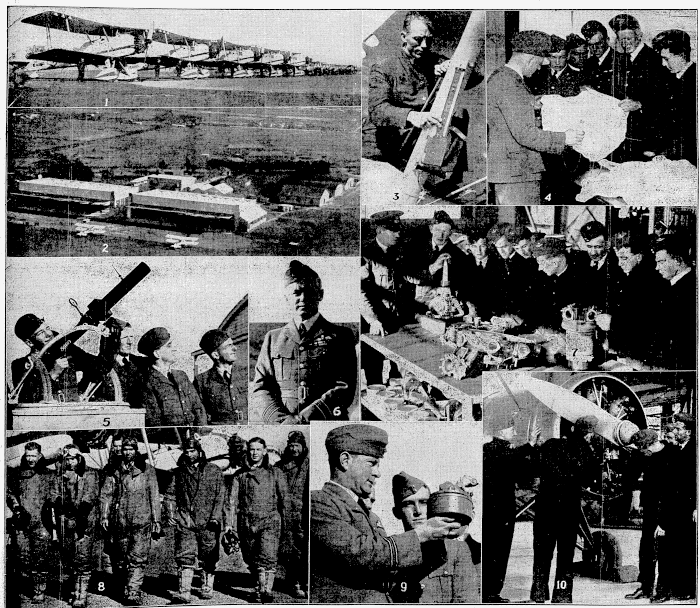|
|
Post by Dave Homewood on Oct 24, 2024 12:42:47 GMT 12
ACCOMMODATION FOR NEW AEROPLANES OF THE ROYAL NEW ZEALAND AIR FORCE.— Good progress has been made with the erection of the first of two new hangars at the Wigram Aerodrome. It is expected that tenders for the second building will be called shortly. The erection of the two hangars is part of a comprehensive scheme for improving Wigram as a service base, following the decision of the Government to build up both the personnel and equipment of the Royal New Zealand Air Force and the Territorial Air Force. The Press, 15 January 1935 
|
|
|
|
Post by tbf2504 on Oct 24, 2024 15:20:42 GMT 12
Note the modern two horse drawn plough
|
|
|
|
Post by Dave Homewood on Oct 26, 2024 12:20:09 GMT 12
New Air Force Hangar.— A photograph of the new hangar now in course of construction at Wigram Aerodrome for the Royal New Zealand Air Force. It has been said that this hangar, when completed, will be the largest in the southern hemisphere. Dominion, 7 December 1935 
|
|
|
|
Post by davidd on Oct 26, 2024 13:19:14 GMT 12
These hangars were specially built for the Vildebeests and Avro 626s. Fortunately the hangar still survives in its original position, as does one of the Avro 626s and one Vildebeest (latter a work in progress!)
|
|
|
|
Post by davidd on Oct 26, 2024 13:23:34 GMT 12
Just to add some background to the earliest buildings at Wigram, if we use Reply No. 6 on this thread as an example, the large concrete hangars furthest from camera and facing out over the landing ground are of course the existing Nos. 4 and 5 hangars, built in 1935 to house the new Vildebeests and Avro 626s (and originally known as No. 1 and 2 concrete hangars). Closer to the viewer, and directly behind the concrete hangars are the original Canterbury Aviation Company hangars and other miscellaneous buildings (all wood of course), which were all finally demolished in about 1940/41 to make way for the new MT workshops. Finally the row of buildings running diagonally across view towards right lower corner are the government-owned buildings erected in 1920 to house the Imperial Gift aircraft, which arrived shortly afterwards. They comprised the stores building with the ridged roof and skylights, plus the two government hangars with the black malthoid-covered curved roofs. These buildings all survived until the late 1970s or early 1980s, with one hangar, as pointed out already, ending up at Ferrymead for the vintage car club, although deliberate lack of the diagonal wall braces soon resulted in its destruction. And I can see two Grebes, three Bristols and three Tomtits at rear, but no signs of any of those Vildebeests or Avro 626s yet! Perhaps they are all safe in those concrete hangars! David D Don't think this post should be here, and cannot think how I got it here, but most certainly my fault! |
|
|
|
Post by Dave Homewood on Nov 3, 2024 21:06:27 GMT 12
Vital Unit of Defence: The Royal New Zealand Air Force Station at Wigram.
 THE STAFF AT THE ROYAL NEW ZEALAND AIR FORCE STATION AT WIGRAM THE STAFF AT THE ROYAL NEW ZEALAND AIR FORCE STATION AT WIGRAM.—A photograph taken yesterday. Seated in the second row front the front (from left) are: Corporal C. Kingsford, Corporal B. O. Gibson, Sergeant F. Goldsmith, Sergeant-Major W.C. Townsend, Sergeant-Major J. E, Duncan, Flying Officer A, E. Willis, Flight Lieutenant C. E. Kay, Flight Lieutenant R. J, Cohen, Flight Lieutenant E. G. Olson, Squadron Leader J. L. Findlay, M.C., Flight Lieutenant R. A. Anderson, M.C., Flying Officer F. R. Newell, Flying Officer G. J, L. Taylor, Sergeant-Major W. S. Simpson, Sergeant-Major F. Sorrell, Sergeant A. E. Pope, and Corporal W, Dini.  GLIMPSES OF THE VARIED COURSE OF TRAINING AT THE WIGRAM AIR STATION.—(I) Some of the aeroplanes in line, with the Vildebeest machines in the foreground. (2) The buildings at the base as seen from the air. (3) A special thermometer attachment for aeroplane soundings of humidity and temperature. (4) Parachute instruction. (S) A camera gun to check a marksman’s accuracy in training, (6) Squadron Leader J. L. Findlay, M.C., the commanding officer of the base. (7) ln the engine repair workshops. (8) Pilot Officers on Probation about to make a flight. (9) Flight Lieutenant C.E. Kay, navigation officer, explaining a compass reading. (10) A lessen in the Assembly of a machine. The Press, 7 August 1937
|
|

